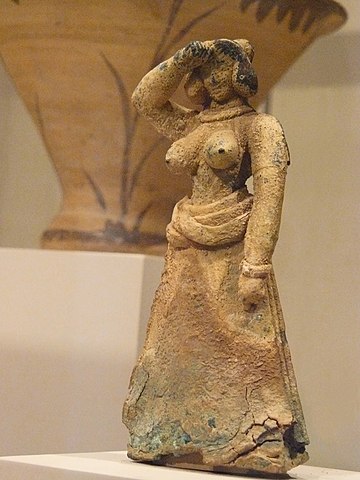Ariadne's Tribe: Minoan Spirituality for the Modern World
Walk the sacred labyrinth with Ariadne, the Minotaur, the Great Mothers, Dionysus, and the rest of the Minoan family of deities. Ariadne's Tribe is an independent spiritual tradition that brings the deities of the ancient Minoans alive in the modern world. We're a revivalist tradition, not a reconstructionist one. We rely heavily on shared gnosis and the practical realities of Paganism in the modern world. Ariadne's thread reaches across the millennia to connect us with the divine. Will you follow where it leads?
Find out all about Ariadne's Tribe at ariadnestribe.com. We're an inclusive, welcoming tradition, open to all who share our love for the Minoan deities and respect for our fellow human beings.
Another Knotty Problem
In my last post I explored the Minoan sacral knot, a religious symbol from ancient Crete that consisted of a length of cord knotted together with a loop at the top, and the sacral scarf, a looped-and-knotted length of fringed fabric.
But these aren’t the only instances of knotwork in Minoan religious iconography. And while the sacral knot may be related to the Egyptian tyet (Isis’ symbol), these other knots are more closely allied with snakes.
When Sir Arthur Evans excavated Knossos more than a century ago, one of the objects he found was a faience figurine of a woman covered in snakes (photo at the top of this post). They twine around her hat, down her chest and arms, and around her belly.
The snakes that cross her belly form a large knot that’s a prominent feature on the figurine. Evans was intrigued by this knot, even going as far as researching whether snakes in the wild ever tie themselves into knots. For the record, blindworms do, but they’re not true snakes, though the Minoans might not have known the difference.
Evans also pointed out that snake-like knots in general are common in Minoan art. This statue of a woman making the ‘Minoan salute’ gesture shows her hair arranged in snake-like loops and coils on her head and down her back.
But what intrigues me even more is this figurine of a woman making the Minoan salute gesture. Her clothing is arranged so a belt or scarf-like item wraps around her belly in a way similar to the snakes on the ‘snake goddess’ figurine.

We also find knots on the skirts of the female figures in the Akrotiri frescoes. These beautiful paintings come from a building in ancient Akrotiri (on the island of Santorini) that appears to have been used for coming-of-age rites for adolescent girls and boys.
The girls and women in the frescoes all wear the same style of clothing, including tiered skirts that have cords or ties wrapped around the top, just below the waist. These ties loop around each other across the belly in much the same way as the other images I’ve shared here. Since the artist went to the trouble of depicting the ties in great detail, I have to think they have some kind of meaning.

From such a great cultural and temporal distance, it’s often hard for us to tell what any of these images and symbols meant to the Minoans.
These knotted belts, cords, and snakes all appear on female figures, and they're all at the waist or upper abdomen. Are they connected symbolically? Do they represent some kind of sacred meaning that we simply haven't figured out yet? What do you think?
Comments
-
Please login first in order for you to submit comments





















